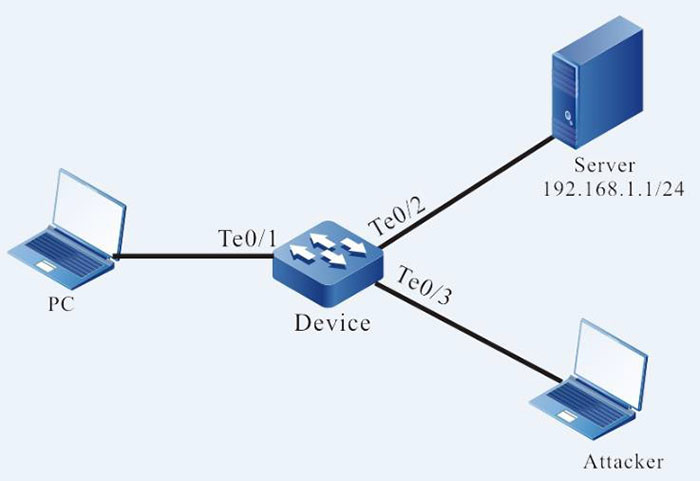Overview Host Guard
The Host Guard function is mainly used to the access layer devices, preventing the ARP packets forged by the attacker from damaging the ARP table on the terminal device. The host IP address protected by Host Guard is usually applied to the IP addresses of the gateway device in the network and important server.
In the Host Guard function, there are two concepts:
- Host Guard group: comprises a series of host guard group rules, that is, the set of the protected host IP addresses;
- Host Guard group rule: One protected host IP address
The work principle of the Host Guard function is as follows:

Figure 10–1 The brief diagram of the Host Guard function
As shown in the above figure, Attacker can make use of the IP address 192.168.1.1 of the Server to forge the ARP packet and forward to PC via Device, damaging the ARP table on PC. As a result, PC cannot access Server normally.
On Device, after applying the IP address of Server 192.168.1.1 as one host guard group rule to port te0/2, when the sending IP address in the ARP packet received by Device is the same as the IP address of Server and if the receiving port is te0/2, the packet can be processed normally; if the receiving port is not te0/2, the packet is dropped. That is, the ARP packet sent by Server can only be forwarded via port te0/2.
The ARP packet forged by Attacker is dropped.
 Switch
Switch Wifi - Access Point
Wifi - Access Point Firewall
Firewall Router
Router Module Quang
Module Quang![Module Quang Cisco]() Module Quang Cisco
Module Quang Cisco![Module quang HPE]() Module quang HPE
Module quang HPE![Module quang Maipu]() Module quang Maipu
Module quang Maipu![Module quang Brocade]() Module quang Brocade
Module quang Brocade![Module quang Fortinet]() Module quang Fortinet
Module quang Fortinet![Module quang Aruba]() Module quang Aruba
Module quang Aruba![Module quang OEM]() Module quang OEM
Module quang OEM![Module quang Juniper]() Module quang Juniper
Module quang Juniper![Module quang Dell]() Module quang Dell
Module quang Dell![Module quang Palo Alto]() Module quang Palo Alto
Module quang Palo Alto![Module quang Huawei]() Module quang Huawei
Module quang Huawei![Module quang Arista]() Module quang Arista
Module quang Arista![Module quang F5]() Module quang F5
Module quang F5![Module quang H3C]() Module quang H3C
Module quang H3C![Module Quang Allied Telesis]() Module Quang Allied Telesis
Module Quang Allied Telesis![Module quang SonicWall]() Module quang SonicWall
Module quang SonicWall![Module quang Mikrotik]() Module quang Mikrotik
Module quang Mikrotik![Module quang Handar]() Module quang Handar
Module quang Handar Máy chủ (Server)
Máy chủ (Server) Thiết bị lưu trữ (SAN, NAS)
Thiết bị lưu trữ (SAN, NAS) Load Balancing
Load Balancing Video Conferencing
Video Conferencing Phụ kiện máy chủ
Phụ kiện máy chủ Thiết Bị IoT
Thiết Bị IoT Phụ Kiện Mạng
Phụ Kiện Mạng




.png)
























